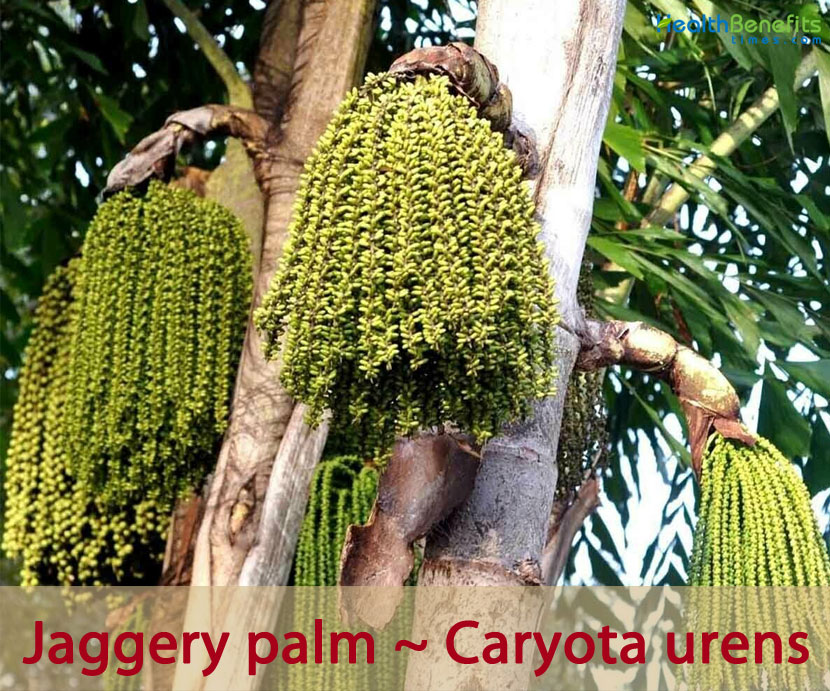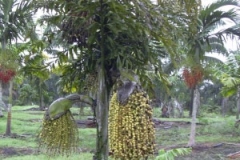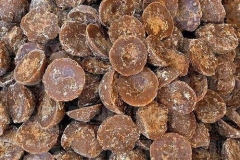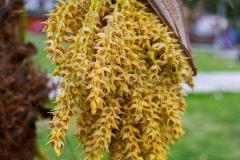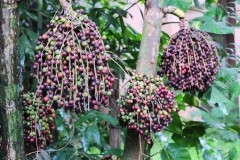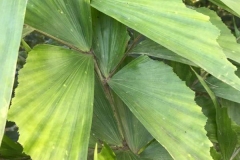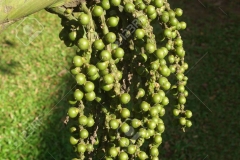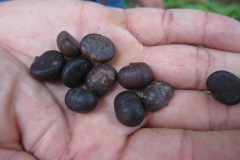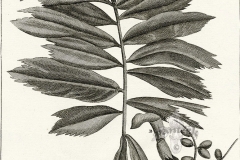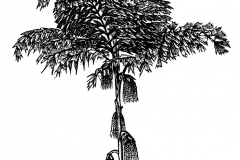It is oftentimes cultivated as an ornamental tree in tropical and sub-tropical climates. The pulp is edible when powdered after sun drying and the leaves when cooked. Sugar and alcoholic beverages can be made using the sap obtained from the plant’s inflorescence, and sago using starch from the stems. However, the fruit may irritate the skin due to its oxalic acid content. Seed flour is made into porridge which can be used to treat gastric ulcers, severe headaches, poisoning by snakebites, and rheumatic swelling. Root is used against tooth discomforts and the bark and seeds against boils. Dried, branchless leaves are used as fishing rods. Leaf bases, on the other hand, are sources of a very strong, fine, soft, and durable fiber used in brooms, brushes, ropes, etc.
Jaggery Palm Facts
| Jaggery palm Quick Facts | |
|---|---|
| Name: | Jaggery palm |
| Scientific Name: | Caryota urens |
| Origin | Sri Lanka , India , Myanmar, and Malaysia (perhaps elsewhere in the Indo-Malay region ) |
| Colors | Green when young turning to scarlet red at maturity |
| Shapes | 1 cm (0.39 in) drupe in pendulous clusters, stalked, ovoid or globose |
| Taste | Sweet |
| Health benefits | Healthy Digestion, Helps Treat Cold and Cough, Acts as an Energy Booster, Helps Reduce Weight, Relieves Constipation, Relieves Many Common Ailments, Heals Migraines, Helps in Weight Loss, Maintain Blood Pressure, Eases Joint Pain, Relieves Menstrual Cramps, Prevents anemia, Purifies blood |
| Name | Jaggery palm |
|---|---|
| Scientific Name | Caryota urens |
| Native | Sri Lanka , India , Myanmar, and Malaysia (perhaps elsewhere in the Indo-Malay region ) where they grow in fields and rainforest clearings, it is believed to have been introduced into Cambodia |
| Common Names | Fishtail palm, Jaggary palm, Jaggery palm, Kitul palm, Kitul-tree, Sago palm, Solitary fishtail palm, Toddy palm, Wine palm, fishtail wine palm, Anapana, Bagani, Bankhajur, Baraflawar, Berli, Berlimad, Bherawa, Bon supari, Cariota, Chao tamol, Chewa gach, Chhau, Dirgha, Dong zong, Gol sago,Guobang, Jaggery palm, Jilugujattu, Kittul, Koondalpanai, Koonthalpanai, Kundapana, Mada, Mari, Rangbhang, Salopa, Shankarjata, Shivajata, Sowat goch, Surmadi, Thippili panai, Tippili, Tum, Tunsae, Vazapana, Yiaobu |
| Name in Other Languages | Arabic: Qaryutat mihraqa (قريوطة محرقة) Bengali: Sopari Brazil: Palmeiro-jaggeri Bulgarian: Vinena palma (винена палма) Central Khmer: Tonsae (ទន្សែ) Chinese: Dong zong, Jiu yu wei kui, Kong que ye zi,Tadasu (董棕) Czech: Palicha žahavá Dutch: Jagerieboom English: Fishtail palm, Jaggery palm, Kitul-tree, Sago palm, Solitary fishtail palm, Toddy palm, Wine palm, Fish tail palm, Solitary fishtail palm, kittool palm Finnish: Malesianeväpalmu French: Caryot brûlant, Palmier céleri, Palmier queue de poisson, caryote brûlante, palmier à sucre German: Brennpalme, Fischschwanzpalme, Kitulpalme, Sagopalme, Ostindische Brennpalme, Toddypalme Hindi: Mari, salphee (सल्फी), Kittul, gud (गुड़), Ban-khajur (बन खजूर) Hungarian: Diópálma Italian: Palma kithul Kannada:, Bagani (ಬಗನಿ), Baini, Bayni, Kondapana, Bayne (ಬಯ್ನೆ), Bagane (ಬಗನೆ), Baine (ಬೈನೆ), Paine (ಪೈನೆ) Konkani: Birlomaad (बिरलोमाड) Korean: Gongjag-yaja (공작야자) Malayalam: Cuuntappana (ചൂണ്ടപ്പന), Aanapana, Ana Pana, Choondappana, Chunda Pana, Chuntappana, Cuntappana, Eerumbana, Erimpana, Irampana, Iram Pana, Kala Pana, Kalippana, Kappa, Konda Pana, Kundapanai, Olatti, Olattipana, Panamkula, Schundapana, Shundrapana, Vainava Marathi: Bherli-maad (भेरली माड), Sur-maad (सुरमाड) Mizo: Mei-hle Nepali: Jagar (जगर) Netherlands: Jagerieboom Oriya: ସଳପ Persian: نخل دمدار تنها Polish: Kariota parząca Portuguese: Palmeira-rabo-de-peixe, Palmeira-toddy, palmeira-brava, palmeira-do-vinho, palmeira-sagu, palmeira-todi, palmeiro-jaggeri Russian: Vinnaya pal’ma (винная пальма), kariota jguçaya (кариота жгучая), ryb’ya pal’ma (рыбья пальма) Sanskrit: Sritalah (श्रीताल), Hoajavriksha, Dirgha, Mada, Madadruma, Madyadru, Madyadruma, Mohakari, Rajju, Sritalah, Vitanaka Sinhalese: Kitul, kæriyōṭa ūrēns (කැරියෝට ඌරේන්ස්) Spanish: Palmera de sagú, palmera de hoja de cola de pez, palmera de vino de la India, palma de cola de pescado Swedish: Fiskstjärtspalm Tamil: Konda panna, Koondalpanai, Kundal panai, Thippali, Tippili, Kūntaṟpaṉai (கூந்தற்பனை), Iram Panai, Konda Panei, Koonthal Panai, Kuntha Panai, Thippili Panei, Kuntaypanai, Tippili-p-panai (திப்பிலிப்பனை), Kontalpanai (கொண்டல் பனை) Telugu: Jeelugu (జీలుగ) Thai: Tèār̂āng (เต่าร้าง) |
| Plant Growth Habit | Medium to large, unarmed, hepa-xanthic, single-stemmed, evergreen palm tree |
| Growing Climates | Limestone areas, valley forests, moist lowland, sub-montane forests |
| Plant Size | Measure up to 15 m (49 ft) in height and up to 30 cm (12 in) wide |
| Trunk | Trunk solitary, annulate, erect, up to 12 m tall, 60-90 cm thick |
| Leaf | Compound, bipinnate (meaning they are divided into leaflets that divide a second time), bright to deep green, 3.5 m (11 ft.) long, and held on 60 cm (24 in) long petioles |
| Flowering season | January – April |
| Flower | Flowers are with 3 sepals and 3 petals. Male flower is with free petals; stamens 6, filaments short, sometimes connate at base. Female flower is globose; petals connate up to half way. Ovary is superior, 3-locular with a single ovule per cell, stigma 3-lobed |
| Fruit Shape & Size | 1 cm (0.39 in) drupe in pendulous clusters, stalked, ovoid or globose |
| Fruit Color | Green when young turning to scarlet red at maturity |
| Seed | Each fruit has 2 large hemispherical seeds with ruminate endosperm |
| Propagation | By seed |
| Taste | Sweet |
| Plant Parts Used | Tender buds, leaves, nuts and roots |
| Health Benefits |
|
| Precautions |
|
Plant Description
Jaggery palm is a medium to large, unarmed, hepa-xanthic, single-stemmed, evergreen palm tree that normally measure up to 15 m (49 ft.) in height and up to 30 cm (12 in) wide. The plant is found growing in limestone areas, valley forests, and moist lowland and sub-montane forests. Widely spaced leaf-scar rings cover its gray trunk which culminates in a 6 m (20 ft.) wide and 6 m tall leaf crown.
Leaves
Leaves are compound, bipinnate (meaning they are divided into leaflets that divide a second time), bright to deep green, 3.5 m (11 ft.) long, and held on 60 cm (24 in) long petioles. The obdeltoid pinnae are 30 cm long with a pointed edge and a jagged edge. The ultimate leaflets have a characteristic shape, somewhat like the tail of a fish, hence the popular English name of fishtail palm.
Inflorescence / Flower
Inflorescence is up to 3 meters long emerging at each leaf node, from top to bottom, producing pendent clusters of white, unisexual flowers, spadices, shortly peduncled, much branched; spathes 3-5; spikelets closely arranged on the rachillae. Flowers are with 3 sepals and 3 petals. Male flower is with free petals; stamens 6, filaments short, sometimes connate at base. Female flower is globose; petals connate up to half way. Ovary is superior, 3-locular with a single ovule per cell, stigma 3-lobed.
Flowering begins at the top of the trunk and proceeds downwards, sometimes for several years, but these plants are monocarpic, the completion of the flower and fruiting process results in the death of the tree. Flowers remain open on each inflorescence for about six weeks.
Fruit
Fertile flowers are followed by 1 cm (0.39 in) drupe in pendulous clusters, stalked, ovoid or globose, dark scarlet red at maturity. Mesocarp is fleshy, filled with abundant, irritant, needlelike crystals. The endocarp is not differentiated. Each fruit has 2 large hemispherical seeds with ruminate endosperm. Like all Caryotas, the fruit contains oxalic acid, a skin and membrane irritant. As these plants are monocarpic, the completion of the flower and fruiting process results in the death of the tree.
Health benefits of Jaggery palm
Commonly known as Karupatti in many regions of south India, palm jaggery is a perfect substitute for refined sugar. It has all the richness of a natural sweetener and none of the shortcomings of its processed alternatives. Here are few of the popular health benefits of using Jaggery palm
1. Healthy Digestion
It may sound strange, but palm jaggery works as a digestive agent. In some regions of India, people take small serving of it after heavy meals to digestion the food. It stimulates the digestive enzymes and helps to cleanse the intestinal tracts.
2. Helps Treat Cold and Cough
Among many other ailments that palm jaggery helps relieve cold and cough is the most common one. Added to a warm cup of tea or water, it helps clear the respiratory tract and relieve several symptoms.
3. Acts as an Energy Booster
Full of composite carbohydrates (as opposed to that in white sugar), palm jaggery is easier to digest. After eating palm jaggery, you can stay energetic for hours.
4. Helps Reduce Weight
Potassium is the nutrient responsible for the weight loss properties of palm jaggery. It helps reduce bloating and water retention, which in turn helps regulate weight.
5. Relieves Constipation
Jaggery palm is full of dietary fibers. These fibers help to treat constipation and indigestion. It helps to clean the system by flushing out unwanted particles. It also stimulates bowel movement.
6. Relieves Many Common Ailments
Palm jaggery was used in ancient times for its medicinal properties. In fact, it was used to treat dry cough and cold. Palm jaggery helps to clear the respiratory tract by dissolving the mucus. If a person who is suffering respiratory problems like asthma can take palm jaggery to treat it.
7. Heals Migraines
Migraine is the most painful of all headaches. Natural medicinal content of palm jaggery helps to reduce this pain. Just take 1 tsp. of palm jaggery, and you will experience relief from migraine.
8. Helps in Weight Loss
This can be startling fact about palm jaggery. Higher count of potassium in this raw sweetener reduces water retention and bloating. As such, your weight loss regimen is well supported by this sweetener.
9. Maintain Blood Pressure
Palm jaggery consists of both potassium and sodium which play an important role in maintaining the acid levels in our body thus, maintaining pressure of the blood flow.
It also reduces water retention in your body. Water retention is due to accumulation of fluid in the extracellular spaces which ends up in swelling of legs, hands and face.
10. Eases Joint Pain
It is rich in calcium which makes the bones healthier and stronger. It strengthens the bones, thus reducing joint pain and other related issues like Arthritis. Experts recommend taking Palm Jaggery with a pinch of ginger or a glass of milk.
11. Relieves Menstrual Cramps
One of the most painful phenomena every month for females is Menstruation. The pain, for many women, is unbearable calling for other pain in the body. Palm Jaggery is rich in nutrients which makes it a natural therapy for menstrual problems. Eating of Palm Jaggery releases Endorphins which relaxes our body.
12. Prevents anemia
To prevent anemia, it is required that adequate levels of RBCs are maintained in the body along with iron and foliate. Jaggery is rich in both iron and folate, hence, a good way to prevent anemia. Doctors often recommend its intake to adolescents and pregnant women.
13. Purifies blood
Consumption of jaggery on a regular basis in moderate amounts can aid in blood purification. This is also the reason why it is effective in treating acne or pimples as cleaner blood also means healthier skin. Additionally, the total hemoglobin count in blood also increases with the consumption of the right amount of it.
Traditional uses and benefits of Jaggery palm
- Porridge prepared from the seed flour is recommended by local physicians to treat gastric ulcers, migraine headaches, and snake-bite poisoning and rheumatic swellings.
- The bark and seed are used to treat boils.
- Tender flowers are used for promoting hair growth.
- It is used as ancient medicine to treat hemicranias and rheumatic swelling.
- Ancient medicine technologies recommend these flowers of the trees are used as a home remedy and improve the hair growth.
- Roots of the trees are used as the tooth ailments.
- Fruit skin and immature fruit is known to have antibacterial activity against the tested pathogens (Escherichia coli, Vibrio cholerae, Salmonella typhii, Staphylococcus aureus and Shigella flexneri).
- Root bark and the terminal bud is used for treating rheumatic swellings and snake bite.
- Pulp of fruit is good for hyperpiesia and fatigue.
- Paste made from the nut is good for hemicrania.
- In Ayurveda, it is recommended for seminal weakness and urinary disorders.
- Palm heart is used locally as flour, especially for control of diabetes and in Ayurvedic medicines.
Ayurvedic Health benefits of Jaggery palm
- Lower Back Pain: Boil 5 gm. Fenugreek Seeds with 18 gm. Jaggery palm in a little water. Drink. Take One tablespoon Mustard oil. Put Carom seeds and Garlic. Let it burn black. Massage with this warm oil.
- Rheumatism: Make small pills by mixing Indian Gooseberry powder with double its amount of Jaggery palm. Take 3 pills daily.
- Heart Disease: Take equal quantity of Arjuna bark and Jaggery palm. Grind. Have a teaspoon powder with one glass milk once a day.
- Fever: Grind Chaff Flowers leaves to make a paste. Take one teaspoon of the paste with 2 teaspoon of crushed Jaggery palm nuts.
Culinary Uses
- Sap extracted from the inflorescence of the plant is used to make sugar and alcoholic beverages.
- A primary product of the plant in rural communities is the sugar substitute called kitul honey or jaggery obtained from the juice from the flowers.
- This is concentrated in large, wide-mouthed vessels on an open fire to prepare a viscous, golden syrup with a delicious flavor.
- The sap can be further concentrated to give kitul jaggery (candy).
- Sap collected from the inflorescence is fermented with a crude, mixed inoculum of yeast to obtain toddy.
- This beverage can be distilled, as is coconut toddy, to prepare a more concentrated spirit.
- A starch obtained from the stems is used to make sago.
- The very young unfolding leaves and leaf bud are used as a vegetable.
- Stem pith is boiled, mixed with rice and cooked.
- The palm heart is edible.
- It is most well known as the source of kithul treacle, a liquid jaggery.
- Sap of the tree is boiled for many hours until it turns into the thick, dark treacle, unique to Sri Lanka.
- Kithul treacle is used as a sweetener in both Sri Lankan and Western cooking.
- Seeds can be used as a masticatory in place of betel nut.
Other facts
- A very strong, fine, soft and durable fiber is obtained from the leaf bases.
- It is used to make a wide range of products, but especially brooms, brushes, ropes, baskets etc.
- It is also used for stuffing cushions.
- Woolly substance, or scurf, scraped from the leaf-stalks is used for caulking boats.
- It is also extensively used in machine brushes for polishing linen and cotton yarns, for cleaning flax fiber after it is scutched, for brushing velvets, and other similar purposes.
- The leaves are used for thatching.
- The mature wood is strong, heavy and durable.
- Stem yields an inferior timber occasionally used for construction purposes, especially in traditional buildings, for purposes such as planking, flooring, rafters, roofing, partitioning and fencing, and also for making spears.
- The stem, cut lengthways in half with its center scooped out, is used for gutters and drains, or to convey water over long distances.
- Polished stems are used as monoliths in modern houses.
- It is suitable for growing indoors.
- Elephants are fed both the leaf and the pulp of this plant.
- Leaves possess strong fibers and are used for basketry in Cambodia, where the plant is named tunsaè.
- Heart of the trunk consists of a starch similar to sago; as well the trunk can be used for building.
- The fruit, when its stiff hairs are removed, is pleasant and sweet to eat.
- The Cambodians cut the stalks to make sugar, which in turn can be made into wine.
- It is also used for stuffing cushions.
- Woolly substance, or scurf, scraped from the leaf-stalks is used for caulking boats.
Other Products
Food: A primary product of C. urens in rural communities is the sugar substitute called kitul honey or jaggery; juice from the flowers is concentrated in large, wide-mouthed vessels on an open fire to prepare a viscous, golden syrup with a delicious flavor. It is often served with a thick, fermented curd, prepared from buffalo milk. Alternatively the sap is further concentrated to give kitul jaggery (candy). The fruits consist of raphides and are normally not eaten, although the seeds may be chewed.
The apical region of the stem of young is used as a food source. The palm heart consisting of the apical meristem together with its immediate derivatives before thickening is eaten as a vegetable by rural people.
Fodder: In Sri Lanka, leaves are traditionally used as a delicacy fodder for domesticated elephants; in areas where the trees are not tapped, they are cut down to feed elephants. The leaves are used for fodder; they contain 2% crude protein and 9.3% crude fiber.
Apiculture: This palm is cultivated for its nectar for honey production.
Fiber: The sheathing leaf bases provide a strong fiber for brushes. In Sri Lanka it is used as a source of fiber resembling horsehair, kitul fiber or kitul toddy.
Timber: Mature wood is strong, heavy and durable. Caryota stem yields an inferior timber occasionally used for construction purposes such as planking, rafters, roofing, partitioning and fencing. In Papua New Guinea, it is commonly used for flooring and making spears. The stem, cut lengthways in 2 with its center scooped out, is used for gutters and drains, or to convey water over long distances. Polished stems are used as monoliths in modern houses.
Alcohol: Sap collected from the inflorescence is fermented with a crude, mixed inoculum of yeast to obtain toddy. The alcoholic beverage prepared can be distilled, as is coconut toddy, to prepare a more concentrated spirit.
Medicine: A porridge prepared from Jaggery palm flour is recommended by local physicians to treat gastric ulcers, migraine headaches, and snake-bite poisoning and rheumatic swellings. The root is used for tooth ailments, the bark and seed to treat boils, and the tender flowers for promoting hair growth.
Other products: Both toddy and jaggery are well-established cottage industries in villages that border forests in the wetter part of Sri Lanka. Villagers who process it receive a substantial income from the sale of jaggery.
Services
Ornamental: As the only palm having bipinnate leaves with fishtail-like leaflets, both young and semi-adult plants are increasingly used as indoor as well as outdoor plants in households, large hotels and airport terminal buildings. The leaves are also used to enhance floral decorations. Unlike ornamental palms such as royal palm and cabbage palm, however, it is not a good candidate for avenue planting because of its relatively short stature and short life span.
References:
https://www.itis.gov/servlet/SingleRpt/SingleRpt?search_topic=TSN&search_value=506745#null
http://www.hear.org/pier/species/caryota_urens.htm
https://npgsweb.ars-grin.gov/gringlobal/taxon/taxonomydetail?id=9290
https://pfaf.org/user/Plant.aspx?LatinName=Caryota+urens
https://en.wikipedia.org/wiki/Caryota_urens
https://www.cabi.org/isc/datasheet/11582
https://davesgarden.com/guides/pf/go/56543/#b
https://gd.eppo.int/taxon/CAWUR
http://www.plantsoftheworldonline.org/taxon/urn:lsid:ipni.org:names:665636-1
https://indiabiodiversity.org/species/show/8791
https://tropical.theferns.info/viewtropical.php?id=Caryota+urens
https://www.researchgate.net/publication/316454299_A_STUDY_ON_THE_BIOEFFICACY_OF_CARYOTA_URENS_L
http://www.flowersofindia.net/catalog/slides/Fishtail%20Palm.html
https://plants.usda.gov/home/plantProfile?symbol=CAUR3


